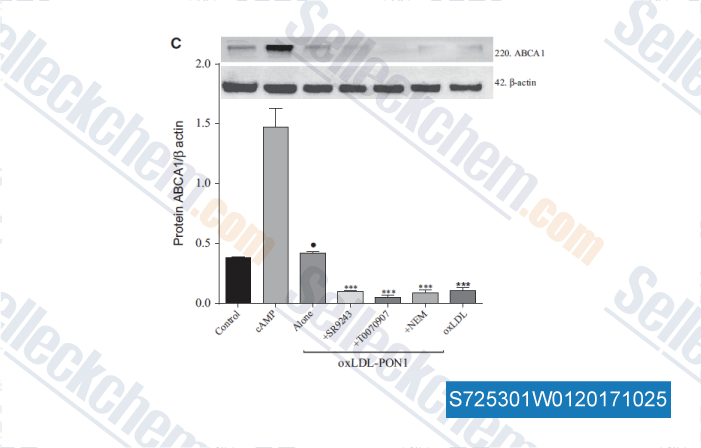|
How to Cite 1. For In-Text Citation (Materials & Methods): 2. For Key Resources Table: |
||
|
Toll Free: (877) 796-6397 -- USA and Canada only -- |
Fax: +1-832-582-8590 Orders: +1-832-582-8158 |
Tech Support: +1-832-582-8158 Ext:3 Please provide your Order Number in the email. We strive to reply to |
Technical Data
| Formula | C21H23N7O3S |
||||||||||
| Molecular Weight | 453.52 | CAS No. | 486424-20-8 | ||||||||
| Solubility (25°C)* | In vitro | DMSO | 7 mg/mL (15.43 mM) | ||||||||
| Water | Insoluble | ||||||||||
| Ethanol | Insoluble | ||||||||||
| In vivo (Add solvents to the product individually and in order) |
|
||||||||||
|
* <1 mg/ml means slightly soluble or insoluble. * Please note that Selleck tests the solubility of all compounds in-house, and the actual solubility may differ slightly from published values. This is normal and is due to slight batch-to-batch variations. * Room temperature shipping (Stability testing shows this product can be shipped without any cooling measures.) |
|||||||||||
Preparing Stock Solutions
Biological Activity
| Description | AZD2858 is a selective GSK-3 inhibitor with an IC50 of 68 nM, activating Wnt signaling, increases bone mass in rats. | ||
|---|---|---|---|
| Targets |
|
||
| In vitro | AZD2858 is a selective GSK-3 inhibitor with an IC50 of 68 nM, inhibits tau phosphorylation at the S396 site, activates Wnt signaling pathway. This compound treatment (1 μM, 12 h) on primary isolated human osteoblast-like cells results in a 3-fold increase of β-catenin levels. [1] It causes β-catenin stabilisation in human and rat mesenchymal stem cells, stimulates hADSC commitment towards osteoblasts and osteogenic mineralisation in vitro. [2] | ||
| In vivo | In rats, oral AZD2858 treatment causes a dose-dependent increase in trabecular bone mass compared to control after a two-week treatment with a maximum effect at a dose of 20 mg/kg once daily (total BMC: 172% of control). A small but significant effect is also seen at cortical sites (total BMC: 111% of control). [1] This compound (30 μmol/kg) on rats daily for up to 3 weeks shows an increase in both mineral density (of 28% at 2 weeks and 38% at 3 weeks) and mineral content (of 81% at 2 weeks and 93% at 3 weeks) in the calluses. This treatment makes the fractures heals more rapidly, with a bony callus without an obvious endochondral component. [3] It produces time-dependent changes in serum bone turnover biomarkers and increases bone mass over 28 days exposure in rats. After 7 days, this compound increases the bone formation biomarker P1NP, and reduces the resorption biomarker TRAcP-5b, indicating increased bone anabolism and reduced resorption in rats. [2] |
Protocol (from reference)
| Kinase Assay:[1] |
|
|---|---|
| Cell Assay:[2] |
|
| Animal Study: [2] |
|
References
|
Customer Product Validation

-
Data from [ , , FEBS Lett, 2016, 590(11):1614-29 ]
Selleck's AZD2858 Has Been Cited by 8 Publications
| Visualization strategies to aid interpretation of high-dimensional genotoxicity data [ Environ Mol Mutagen, 2024, 10.1002/em.22604] | PubMed: 38757760 |
| Establishment and characterization of immortalized sweat gland myoepithelial cells [ Sci Rep, 2022, 12(1):7] | PubMed: 34997030 |
| The small molecule DIPQUO promotes osteogenic differentiation via inhibition of glycogen synthase kinase 3 β signaling [ J Biol Chem, 2021, S0021-9258(21)00485-3] | PubMed: 33895139 |
| A novel human colon signet-ring cell carcinoma organoid line: establishment, characterization and application [ Carcinogenesis, 2020, 41(7):993-1004] | PubMed: 31740922 |
| Integrin alpha11 is an Osteolectin receptor and is required for the maintenance of adult skeletal bone mass. [ Elife, 2019, 10.7554/eLife.42274] | PubMed: 30632962 |
| Predictions of genotoxic potential, mode of action, molecular targets, and potency via a tiered multiflow® assay data analysis strategy [ Environ Mol Mutagen, 2019, 60(6):513-533] | PubMed: 30702769 |
| SFRP2 enhanced the adipogenic and neuronal differentiation potentials of stem cells from apical papilla. [Lin X, et al. Cell Biol Int, 2017, 41(5):534-543] | PubMed: 28244619 |
| Investigating the Generalizability of the MultiFlow ® DNA Damage Assay and Several Companion Machine Learning Models With a Set of 103 Diverse Test Chemicals. [ Toxicol Sci, 2017, 162(1):146-166] | PubMed: 29106658 |
RETURN POLICY
Selleck Chemical’s Unconditional Return Policy ensures a smooth online shopping experience for our customers. If you are in any way unsatisfied with your purchase, you may return any item(s) within 7 days of receiving it. In the event of product quality issues, either protocol related or product related problems, you may return any item(s) within 365 days from the original purchase date. Please follow the instructions below when returning products.
SHIPPING AND STORAGE
Selleck products are transported at room temperature. If you receive the product at room temperature, please rest assured, the Selleck Quality Inspection Department has conducted experiments to verify that the normal temperature placement of one month will not affect the biological activity of powder products. After collecting, please store the product according to the requirements described in the datasheet. Most Selleck products are stable under the recommended conditions.
NOT FOR HUMAN, VETERINARY DIAGNOSTIC OR THERAPEUTIC USE.
